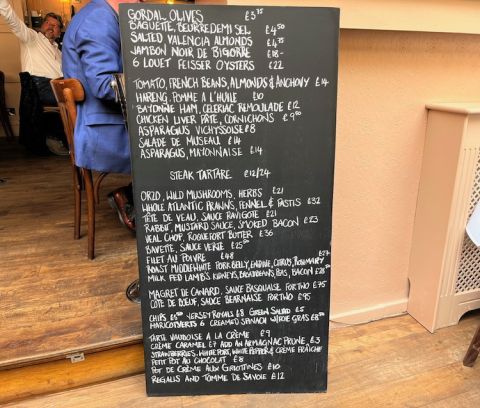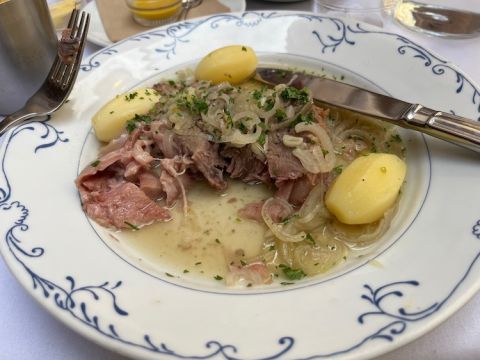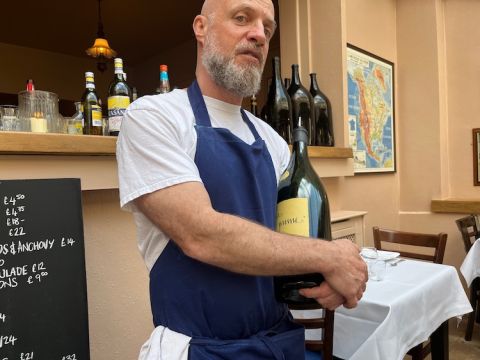I first wrote about Harris shortly after he, and his then front-of-house partner Eric Garnier, opened the initial Racine on Brompton Road, London, in 2002. I then picked his brains for an article about how men and women seem to differ in choosing dishes from a restaurant menu: men typically choose the protein first, reading the menu from left to right, whereas women often choose the vegetables and accompaniments first, apparently paying the protein element less attention.
After 2015, when the original Racine closed, Harris’s professional career meandered. He worked on a series of pubs in the country but left there when the owners tried to insist on a Goan fish curry and fish and chips appearing on his traditionally French menu. Whether a cheeseburger was the appropriate inclusion on the bar menu of a small group of restaurants owned by fishmongers led to another parting of the ways and his working relationship with a small group of London pubs ended with the pandemic.
From all of this you may conclude that Harris is the stereotypical, hard-nosed chef who will never change. That conclusion would be harsh. Rather he has developed a style of cooking that is his own – honed at the outset by eight years working for Simon Hopkinson at Hilaire and Bibendum – but one that is of universal appeal. His cooking is French bourgeois: neither that of a cafe nor a restaurant but that of a bouchon, one of the small places in Lyon that offer traditional French cooking, primarily meat with some offal thrown in. And, for the time being at least, his new London restaurant Bouchon Racine is thriving.
It’s in a very different location from Harris’s original Racine. This second one, which opened just before Christmas 2022, is reached via a very steep set of stairs above the Three Compasses pub close to Farringdon station, east of London’s city centre and west of the City financial district. Harris’s landlord is the brewer Heineken, from whom as a tied tenant he has to buy all his beer and his soft drinks. But not his wines or spirits.
He ended up here by happenstance. After his final foray into consultancy, he had decided that his only future lay in being self-employed once more, a decision with which his wife Denise happily agreed. That cheffing was a profession predominantly for the young at heart and young of body was a thought that did not occur to him, despite the fact that he will shortly turn 60. He began to look around and the space at the Three Compasses came up on his radar frequently.
At first Harris showed indifference. There was an opportunity to take over Le Café du Marché in Smithfield nearby but the vendors showed little enthusiasm for a possible name change and insisted on a lunchtime set menu, another point on which Harris remains steadfast (‘throwing good money after bad’ were his words about this addition to a regular lunchtime menu). Then he finally came to see the space above the Three Compasses and he liked it very much indeed.
‘The kitchen is on the same floor as the dining room, which is important because it means that the chefs can double up as waiters if necessary’, he observed, adding, ‘also there is plenty of natural light.’ He continued, with a touch of bravado, ‘I did ten double shifts – five lunches and five dinners – last week.’
The space has been a restaurant for quite a while, serving Thai food before Harris’s arrival. This brings two further advantages: the main services are all there and there is a feeling as one walks into the room of a well-worn, friendly establishment. No aggressively new smells. The wooden chairs. The crisp linen on the table. The sunlight that streams in from both sides. The whole place feels as though it has been serving good French food for nine years rather than for almost nine months.
A member of the waiting staff carries the blackboard menu to your table. There are no surprises but it is extremely difficult to choose. To start you off, there are gordal olives from Spain; baguette with demi-sel butter; and half a dozen Louët-Feisser oysters, which, despite their name, come from the cold waters around Carlingford in Ireland.
Seven first-course choices follow. Asparagus two ways, first as a vichyssoise then with mayonnaise; a chicken-liver pâté with cornichons; a salad of tomatoes, French beans, almonds and anchovies; and, in Lyonnais style, a salade de museau, a salad made from the flesh of a pig’s head. We chose two dishes to test the kitchen: ‘hareng, pomme a l’huile’ for £10, to test how the kitchen prepares the potatoes (firm but not too firm); and celeriac remoulade with Bayonne ham (£12). The celeriac must be thin, but not overly so and the dressing must be full of mustard. Both were excellent.
The list of main courses starts with a vegetarian dish and a fish dish – orzo with wild mushrooms and herbs, and Atlantic prawns with fennel on the day we ate there. But main courses are primarily for meat eaters. There is a veal chop with Roquefort butter; a fillet steak ‘au poivre’ that has been on Harris’s menu since Hilaire; and a dish of rabbit with smoked bacon and a mustard sauce that has almost become his signature dish.
Then there is the single dish that I have come to associate with Harris, a plate of tête de veau with sauce ravigote (an enthusiasm for which I do not expect everyone to share). The soft meat is slowly cooked and its flesh heightened by the acidity of the sauce. Whichever main course you choose, I advise you to add an order of the chips, which are expertly salted.
The dessert menu reads extremely enticingly. There is a rich petit pot au chocolat; a delicious-sounding pot de crème aux griottines; and a classic tarte vaudoise à la crème that was the hallmark of the late Frédy Girardet.
There is also a crème caramel, a version of which any Harris kitchen produces with great delicacy and richness, accentuated by the addition of a prune steeped in armagnac. I happily paid my bill of £120.17 for two, which included four glasses of Domaine de Fa’s Beaujolais En Besset 2020 and one espresso.
An added attraction is the service, which is as friendly as you would like it to be. Front of house is the responsibility of Dave Strauss, below, who has worked in this milieu for many years, firstly for Zelman Meats and more recently for Mitch Tonks’ group of seafood restaurants. Strauss fits my bill of the ideal waiter and is at home taking orders, serving plates of delicious food and dispensing glasses of vieille prune from a magnum.
Harris met Strauss while he was looking at sites and they hit it off. Every morning Strauss travels in from his home in Brighton. They meet in the quiet of the restaurant, drink coffee and, in Harris’s words, ‘talk about nothing’. They then go their separate ways to run the service.
Harris admitted he was surprised at the enormous amount of publicity and coverage the opening of his 40-seater restaurant has generated (it is extremely difficult to get a booking here!). ‘Just before we opened, we had no PR, and I told Catherine and Gavin Hanly, the brother and sister who run the Hot Dinners website, and they wrote something. That was it. But I think that the type of food we are cooking is widely understood and there are still a few restaurant writers who remember me’, he added with a smile.
Smiling has always come easily to Harris but I was delighted to hear him say as we neared the end of our lunch together, ‘I never became a chef to get rich. That would have been a ridiculous plan. But I do believe that I am happier cooking today than I have ever been. There is Chris Handley, a very experienced chef, beside me in the kitchen and since February our son Noah is working here and seemingly spending everything he earns on second-hand cookery books. How could I be happier?’
Bouchon Racine above The Three Compasses pub, 66 Cowcross Street, London EC1M 6BP; tel +44 (0)20 7253 3368.
Open Tuesday to Saturday, lunch and dinner.


















